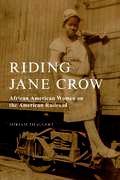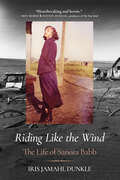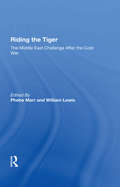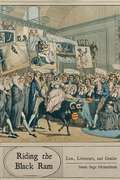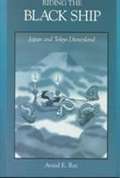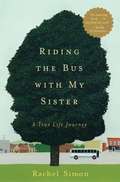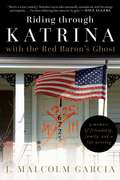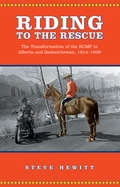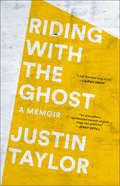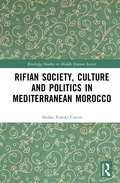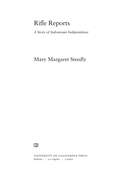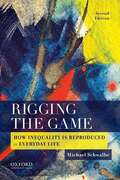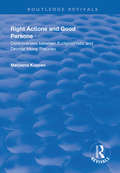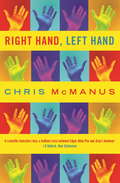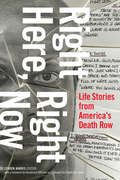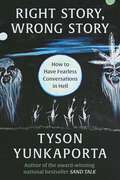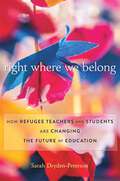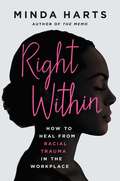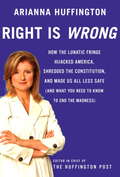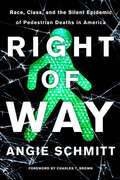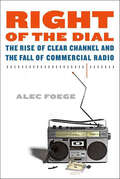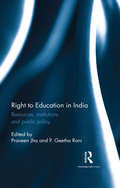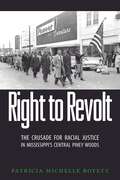- Table View
- List View
Riding Jane Crow: African American Women on the American Railroad (Women, Gender, and Sexuality in American History)
by Miriam ThaggertMiriam Thaggert illuminates the stories of African American women as passengers and as workers on the nineteenth- and early-twentieth-century railroad. As Jim Crow laws became more prevalent and forced Black Americans to "ride Jim Crow" on the rails, the train compartment became a contested space of leisure and work. Riding Jane Crow examines four instances of Black female railroad travel: the travel narratives of Black female intellectuals such as Anna Julia Cooper and Mary Church Terrell; Black middle-class women who sued to ride in first class "ladies’ cars"; Black women railroad food vendors; and Black maids on Pullman trains. Thaggert argues that the railroad represented a technological advancement that was entwined with African American attempts to secure social progress. Black women's experiences on or near the railroad illustrate how American technological progress has often meant their ejection or displacement; thus, it is the Black woman who most fully measures the success of American freedom and privilege, or "progress," through her travel experiences.
Riding Like the Wind: The Life of Sanora Babb
by Iris Jamahl DunkleThis saga of a writer done dirty resurrects the silenced voice of Sanora Babb, peerless author of midcentury American literature. In 1939, when John Steinbeck's The Grapes of Wrath was published, it became an instant bestseller and a prevailing narrative in the nation's collective imagination of the era. But it also stopped the publication of another important novel, silencing a gifted writer who was more intimately connected to the true experiences of Dust Bowl migrants. In Riding Like the Wind, renowned biographer Iris Jamahl Dunkle revives the groundbreaking voice of Sanora Babb. Dunkle follows Babb from her impoverished childhood in eastern Colorado to California. There, she befriended the era's literati, including Ray Bradbury and Ralph Ellison; entered into an illegal marriage; and was blacklisted by the House Un-American Activities Committee. It was Babb's field notes and oral histories of migrant farmworkers that Steinbeck relied on to write his novel. But this is not merely a saga of literary usurping; on her own merits, Babb's impact was profound. Her life and work feature heavily in Ken Burns's award-winning documentary The Dust Bowl and inspired Kristin Hannah in her bestseller The Four Winds. Riding Like the Wind reminds us with fresh awareness that the stories we know—and who tells them—can change the way we remember history.
Riding The Tiger: The Middle East Challenge After The Cold War
by Phebe Marr William LewisThis book is the outgrowth of a collaborative effort by a small group of national security analysts associated with the Institute forNational Strategic Studies of the National Defense University,government officials responsible for pondering defense and foreign policy issues, and academics with long experience in Middle Eastern affairs. In the past several years these scholars, policy analysts, and military planners have been focusing on the impact on U.S. goals and interests in the Middle East of three seminal events-the ending of the cold war, the collapse of the Soviet Union, and the invasion of Kuwaitby Saddam Husayn and the subsequent Gulf War. The authors'individual studies have been nourished by frequent intellectual exchanges with one another and by their participation in numerous academic meetings designed to explore the future of U.S. relations with the Middle East.
Riding the Black Ram
by Susan Sage HeinzelmanHeinzelman (English, U. of Texas at Austin) juxtaposes legal and literary narratives within their historical contexts in order to demonstrate how they are mutually constitutive and in order to reveal how both narrative approaches are articulated within a nomos, as understood in Robert M. Cover's 1983 essay "Foreword: Nomos and Narrative" as the overall normative universe. However, finding Cover's regulating nomos to exclude women's experiences and to privilege male kinship relationships, she coins the term nostos as a necessary supplement to nomos that articulates its gendered nature and, in contrast to nomos's production of narratives of regulation and equity, identifies and produces otherwise unarticulated and gendered narratives of desire. Chapters discuss the juxtaposition of the Chaucer's "Man of Law's Tale" with the "Wife of Bath's Tale, the juxtaposition of 17th and 18th-century romance novels by French and English women writers with juridical narratives, how the disciplinary and generic formation and policing of novelistic and legal discourses in the 17th and 18th centuries are disturbed and gendered by Mary Delarivier Manley's 1714 novel Rivella, the operation of discursive boundaries in three narratives of a 1752 trial of a woman for the murder of her father, and the gendered and sexualized tropes found in cultural representations of three queens (including a cartoon of Queen Caroline published during her 1820 trial for treasonous adultery that depicts the queen as riding a black ram into the House of Lords, which Heinzelman reads as a metaphor for women's disruptive presence). Annotation ©2010 Book News, Inc. , Portland, OR (booknews. com)
Riding the Black Ship: Japan and Tokyo Disneyland
by Aviad E. RazIn 1996 over 16 million people visited Tokyo Disneyland, making it the most popular of the many theme parks in Japan. Since it opened in 1983, Tokyo Disneyland has been analyzed mainly as an example of the globalization of the American leisure industry and its organizational culture, particularly the "company manual." By looking at how Tokyo Disneyland is experienced by employees, management, and visitors, Aviad Raz shows that it is much more an example of successful importation, adaptation, and domestication and that it has succeeded precisely because it has become Japanese even while marketing itself as foreign. Rather than being an agent of Americanization, Tokyo Disneyland is a simulated "America" showcased by and for the Japanese. It is an "America" with a Japanese meaning.
Riding the Bus with My Sister: A True Life Journey
by Rachel SimonThis is an unusual memoir, framed by the year the author spent riding the buses of a Pennsylvania city with her sister Beth. Beth, who has mild mental retardation and lives in her own apartment, spends six days a week riding the buses from route to route. At times the author and the rest of the family are distressed by Beth's lack of purpose and ambition, and press her to get a job. When she agrees to accompany Beth on her rides, the author comes to understand how Beth has built a sense of community through her unconventional lifestyle. The various bus drivers, each portrayed as a unique individual, form a richly varied extended family for this otherwise isolated woman. In spending time with Beth riding the buses, the author opens her life to others and embarks upon her own inner journey.
Riding the Nightmare: Women and Witchcraft from the Old World to Colonial Salem
by Selma Williams Pamela Williams AdelmanSince ancient times, women practiced the art of healing with herbs, and developed a spiritual connection with the natural world. In the 15th century the Catholic Church, under threat from a variety of social upheavals in western Europe, launched an all-out attack against heretics and persons considered to be practitioners of witchcraft. For more than 200 years witches (mostly, but not wholly female) were accused, tried, and frequently put to death. The author traces the history of witchcraft, weaving in mythology about powerful women of ancient times. She shows how both Catholic and Protestant churches used the fear of witchcraft as a means to force compliance. The crusade against witches came to New England with the Puritans and reached its highest pitch in Salem, Massachusetts, in 1692.
Riding through Katrina with the Red Baron's Ghost: A Memoir of Friendship, Family, and a Life Writing
by J. Malcolm GarciaThe first book that J. Malcolm Garcia ever bought would impact his life in a way that the then twelve-year-old could have never imagined. The Day the Red Baron Died plunged Garcia into the intrigue and excitement of the World War I German flying ace's life and death. Garcia was enraptured and brimming with questions. His mother encouraged the curious boy to write to the book's author, Dale M. Titler. When the author replied, a friendship began that shaped Garcia's life. In Riding through Katrina with the Red Baron's Ghost, Garcia chronicles his relationship with Titler. It was that connection that brought Garcia to New Orleans only two weeks after Hurricane Katrina devastated the city and its citizens. Not having heard from his friend in years, Garcia made the split-second decision to go to New Orleans to try to find the man who meant so much to him. A harrowing account of New Orleans directly after Katrina?told in Garcia's award-winning journalistic style?Riding through Katrina with the Red Baron's Ghost tells a personal story of a thirty-year bond that defined a young man, as well as the universal story of the horror and devastation Katrina left in its wake.
Riding to the Rescue
by Steve HewittThe Mountie may be one of Canada's best-known national symbols, yet much of the post-nineteenth century history of the Royal Canadian Mounted Police remains unexamined, particularly the period between 1914 and 1939, when the RCMP underwent enormous transformation. The nature of this transformation as it took place in Alberta and Saskatchewan - where the Mounties have traditionally dominated policing - is the focus of Steve Hewitt's Riding to the Rescue. During the 1914-to-1939 period, the nineteenth-century model of the RCMP was evolving into a twentieth-century version, and the institution that emerged responded to a nation that was being transformed as well. Forces such as industrialization, mass immigration, urbanization, and political radicalism compelled the Mounties to look away from the frontier and toward a new era.Incorporating previously classified material, which explores the RCMP both in the context of its ordinary policing role and in its work as Canada's domestic spy agency, Hewitt demonstrates how much of the impetus behind the RCMP's transformation was ensuring its own survival and continued relevance. Riding to the Rescue is a provocative and incisive look behind one of Canada's most enduring icons at the cusp of the modern era.
Riding with the Ghost: A Memoir
by Justin TaylorAn unflinching memoir from a writer reckoning with his relationship with his troubled father and the complicated legacy that each generation hands down to the next&“Justin Taylor&’s relentless, peripatetic, and tender search for reconciliation with his late troubled father blooms into a full-throated song of joy about his own life lived through music, teaching, travel, and literature.&”—Lauren Groff, author of FloridaWhen Justin Taylor was thirty, his father, Larry, drove to the top of the Nashville airport parking garage to take his own life. Thanks to the intervention of family members, he was not successful, but the incident forever transformed how Taylor thinks of his father, and how he thinks of himself as a son.Moving back and forth in time from that day, Riding with the Ghost captures the past&’s power to shape, strengthen, and distort our visions of ourselves and one another. We see Larry as the middle child in a chilly Long Island family; as a beloved Little League coach who listens to kids with patience and curiosity; as an unemployed father struggling to keep his marriage together while battling long-term illness and depression. At the same time, Taylor explores how the work of confronting a family member&’s story forces a reckoning with your own. We see Taylor as a teacher, modeling himself after his dad&’s best qualities; as a caregiver, attempting to provide his father with emotional and financial support, but not always succeeding; as a new husband, with a dawning awareness of his own depressive tendencies.With raw intimacy, Riding with the Ghost lays bare the joys and burdens of loving a troubled family member. It&’s a memoir about fathers and sons, teachers and students, faith and illness, and the pieces of our loved ones that we carry with us always.
Rifian Society, Culture and Politics in Mediterranean Morocco (Routledge Studies in Middle Eastern Society)
by Stefan Festini CuccoThis book explores the Moroccan Rif and the city of Al Hoceima, combining local voices and ethnographic insights to provide a comprehensive and unique overview of the multifaceted dynamics of the Mediterranean region.The focus of the book is on the society, culture, and people of the region, namely the Rifians. Throughout, their voices are interwoven with first-hand ethnographic data, geographical, ethnohistorical, and anthropological insights, as well as 100 photographs, giving the reader an in-depth understanding of Rifian society and culture. The book also considers other themes, including maritime and mountain economies, ecologies in times of climatic change, transregional entanglements, migration, and the tense relationship between the Rif's inhabitants and the Moroccan monarchy. This book places particular emphasis on the generation of young Rifians who took to the streets in 2016–17 after the tragic death of a fishmonger in Al Hoceima. After months of protests involving thousands of people, at times spreading to other cities in Morocco and as far as Europe, the Makhzen, the power elite that governs Morocco, eventually took back the stage and crushed the popular protest movement. Today, despite the apparent calm, the situation in the region remains tense beneath the surface.Examining a wide range of topics related to the Rifians in northern Morocco, the book will appeal to anyone interested in the Mediterranean region, Middle Eastern society, and anthropology.
Rifle Reports
by Mary Margaret SteedlyOn August 17, 1945, Indonesia proclaimed its independence from Dutch colonial rule. Five years later, the Republic of Indonesia was recognized as a unified, sovereign state. The period in between was a time of aspiration, mobilization, and violence, in which nationalists fought to expel the Dutch while also trying to come to grips with the meaning of "independence." Rifle Reports is an ethnographic history of this extraordinary time as it was experienced on the outskirts of the nation among Karo Batak villagers in the rural highlands of North Sumatra. Based on extensive interviews and conversations with Karo veterans, Rifle Reports interweaves personal and family memories, songs and stories, memoirs and local histories, photographs and monuments, to trace the variously tangled and perhaps incompletely understood ways that Karo women and men contributed to the founding of the Indonesian nation. The routes they followed are divergent, difficult, sometimes wavering, and rarely obvious, but they are clearly marked with the signs of gender. This innovative historical study of nationalism and decolonization is an anthropological exploration of the gendering of wartime experience, as well as an inquiry into the work of storytelling as memory practice and ethnographic genre.
Rigging the Game: How Inequality is Reproduced in Everyday Life
by Michael SchwalbeIn Rigging the Game Michael Schwalbe offers a clear and compelling introduction to how the rules that shape economic life and everyday interaction generate and perpetuate inequality in American society. Guided by the questions How did the situation get this way? and How does it stay this way?, Schwalbe tracks inequality from its roots to its regulation. With its lively combination of analysis and stories, Rigging the Game is an innovative tool for teaching about the inequalities of race, class, and gender. In the final chapter, "Escaping the Inequality Trap," Schwalbe helps students understand how inequality can be challenged and overcome.
Right Actions and Good Persons: Controversies Between Eudaimonistic and Deontic Moral Theories (Routledge Revivals)
by Marjaana KopperiFirst published in 1999, this work tests the ancient against the modern in discussing whether modern approaches to ethics remain sufficiently able to provide a serious and justifiable account of morality. Marjaana Kopperi explores ancient, medieval and enlightenment philosophy to compare their notion of moral agents and ‘the good life’ with the more action-based notions of modern philosophy. Kopperi aims to examine how the promoters of agent-based ethical views deal with questions of what constitutes a good life and whether it can or should be quantified or justified.
Right Hand, Left Hand: A Special Issue Of Laterality (Special Issues Of Laterality Ser.)
by Chris McManusWinner of the Aventis Science Book Prize. 'A scientific detective story, a brilliant cross between Edgar Allan Poe and Gray's anatomy' J G Ballard, New Stateman Books of the Year'Fascinating' New Scientist'Wonderful' Nature- What is the connection between Paul McCartney, Leonardo Da Vinci and Babe Ruth?- Why are parrots and peacocks left-footed?- Do left-handers behave differently from right-handers?- Why are most people right-handed?- Why are all muppets left-handed?- Why is the heart on the left-hand side of the body?- Why is each side of the human brain so different?RIGHT HAND, LEFT HAND uses sources as diverse as the paintings of Rembrandt and the sculpture of Michelangelo, the behaviour of Canadian cichlid fish and the story of early cartography. Modern cognitive science, the history of the Wimbledon tennis championship and the biographies of great musicians are also used to explain the vast repertoire of 'left-right' symbolism that permeates our everyday lives.
Right Hand, Left Hand: The multiple award-winning true life scientific detective story
by Chris McManusWinner of the Aventis Science Book Prize. 'A scientific detective story, a brilliant cross between Edgar Allan Poe and Gray's anatomy' J G Ballard, New Stateman Books of the Year'Fascinating' New Scientist'Wonderful' Nature- What is the connection between Paul McCartney, Leonardo Da Vinci and Babe Ruth?- Why are parrots and peacocks left-footed?- Do left-handers behave differently from right-handers?- Why are most people right-handed?- Why are all muppets left-handed?- Why is the heart on the left-hand side of the body?- Why is each side of the human brain so different?RIGHT HAND, LEFT HAND uses sources as diverse as the paintings of Rembrandt and the sculpture of Michelangelo, the behaviour of Canadian cichlid fish and the story of early cartography. Modern cognitive science, the history of the Wimbledon tennis championship and the biographies of great musicians are also used to explain the vast repertoire of 'left-right' symbolism that permeates our everyday lives.
Right Here, Right Now: Life Stories from America's Death Row
by Lynden HarrisUpon receiving his execution date, one of the thousands of men living on death row in the United States had an epiphany: “All there ever is, is this moment. You, me, all of us, right here, right now, this minute, that's love.” Right Here, Right Now collects the powerful, first-person stories of dozens of men on death rows across the country. From childhood experiences living with poverty, hunger, and violence to mental illness and police misconduct to coming to terms with their executions, these men outline their struggle to maintain their connection to society and sustain the humanity that incarceration and its daily insults attempt to extinguish. By offering their hopes, dreams, aspirations, fears, failures, and wounds, the men challenge us to reconsider whether our current justice system offers actual justice or simply perpetuates the social injustices that obscure our shared humanity.
Right Story, Wrong Story: How to Have Fearless Conversations in Hell
by Tyson YunkaportaContinuing the work of the award-winning Sand Talk, Tyson Yunkaporta casts an Indigenous lens on contemporary society, challenging us to face conflict and embrace conversation to find our way onto the right track. With Right Story, Wrong Story, Apalech Clan member Tyson Yunkaporta, from far north Queensland, tackles the divisions that prevent us from talking to one another. Yunkaporta invites us to confront life’s biggest questions and arms us with the tools we need to really listen, and to open our minds to change based upon our connections with others. He makes this point through discussions with a diverse range of people across social and political divides including:liberal economistsmemorization expertsFrisian ecologistsand Elders who are wood carvers, mathematicians, and storytellers.Building upon the Indigenous tradition of “yarning” to weave our individual narratives into the great narrative that includes us all across any and all differences, Yunkaporta argues that story is at the heart of everything. But what is right or wrong story?
Right Where We Belong: How Refugee Teachers and Students Are Changing the Future of Education
by Sarah Dryden-PetersonA leading expert shows how, by learning from refugee teachers and students, we can create for displaced children—and indeed all children—better schooling and brighter futures. Half of the world’s 26 million refugees are children. Their formal education is disrupted, and their lives are too often dominated by exclusion and uncertainty about what the future holds. Even kids who have the opportunity to attend school face enormous challenges, as they struggle to integrate into unfamiliar societies and educational environments. In Right Where We Belong, Sarah Dryden-Peterson discovers that, where governments and international agencies have been stymied, refugee teachers and students themselves are leading. From open-air classrooms in Uganda to the hallways of high schools in Maine, new visions for refugee education are emerging. Dryden-Peterson introduces us to people like Jacques—a teacher who created a school for his fellow Congolese refugees in defiance of local laws—and Hassan, a Somali refugee navigating the social world of the American teenager. Drawing on more than 600 interviews in twenty-three countries, Dryden-Peterson shows how teachers and students are experimenting with flexible forms of learning. Rather than adopt the unrealistic notion that all will soon return to “normal,” these schools embrace unfamiliarity, develop students’ adaptiveness, and demonstrate how children, teachers, and community members can build supportive relationships across lines of difference. It turns out that policymakers, activists, and educators have a lot to learn from displaced children and teachers. Their stories point the way to better futures for refugee students and inspire us to reimagine education broadly, so that children everywhere are better prepared to thrive in a diverse and unpredictable world.
Right Within: How to Heal from Racial Trauma in the Workplace
by Minda HartsFrom the powerhouse author of The Memo, the essential self-help book for women of color to heal—and thrive—in the workplace In workplaces nationwide, women of color need frank talk and honest advice on how to deal with microaggressions, heal from racialized trauma, and find relief from invisible workplace burdens. Filled with Minda Harts&’s signature wit and warmth, Right Within offers strategies for women of color to speak up during racialized moments with managers and clients, work through past triggers they may not even know still cause pain, and reframe past career disappointments as opportunities to grow into a new path. Through action points, exercises, and clear-eyed coaching, Harts encourages women to summon hidden reserves of strength and courage. She includes advice from therapists and faith leaders of color on a full range of ways to heal. Right Within will help women of color strengthen their resolve across corporate America, ensuring that we can all, finally, rise together.
Right is Wrong
by Arianna HuffingtonWith her trademark passion, intelligence, and devastating wit, Huffington Post editor in chief Arianna Huffington tackles the issues that are crucial to this year's presidential election and, even more so, to the fate of the country.Huffington makes the case that America has been hijacked from within by a radical element--the "lunatic fringe" of the Right that has taken over the Republican Party. Despite holding views at odds with the majority of Americans, these zealots have given us an endless war in Iraq, a sputtering economy, a health care system on life support, a war on science and reason, and an immoral embrace of torture.But they haven't done it on their own: they have been enabled by a compliant media that act as if there is no such thing as truth and are more interested in cozying up to those in power than in holding them accountable, and by feckless Democrats who have allowed themselves to be intimidated into backing down again and again.Both a withering indictment and a hopeful call to arms, Right Is Wrong is an explosive, boldly incisive work that will help set the national agenda.From the Hardcover edition.
Right of Way: Race, Class, and the Silent Epidemic of Pedestrian Deaths in America
by Angie SchmittThe face of the pedestrian safety crisis looks a lot like Ignacio Duarte-Rodriguez. The 77-year old grandfather was struck in a hit-and-run crash while trying to cross a high-speed, six-lane road without crosswalks near his son's home in Phoenix, Arizona. He was one of the more than 6,000 people killed while walking in America in 2018. In the last ten years, there has been a 50 percent increase in pedestrian deaths.The tragedy of traffic violence has barely registered with the media and wider culture. Disproportionately the victims are like Duarte-Rodriguez—immigrants, the poor, and people of color. They have largely been blamed and forgotten.In Right of Way, journalist Angie Schmitt shows us that deaths like Duarte-Rodriguez's are not unavoidable "accidents.&” They don't happen because of jaywalking or distracted walking. They are predictable, occurring in stark geographic patterns that tell a story about systemic inequality. These deaths are the forgotten faces of an increasingly urgent public-health crisis that we have the tools, but not the will, to solve. Schmitt examines the possible causes of the increase in pedestrian deaths as well as programs and movements that are beginning to respond to the epidemic. Her investigation unveils why pedestrians are dying—and she demands action. Right of Way is a call to reframe the problem, acknowledge the role of racism and classism in the public response to these deaths, and energize advocacy around road safety. Ultimately, Schmitt argues that we need improvements in infrastructure and changes to policy to save lives.Right of Way unveils a crisis that is rooted in both inequality and the undeterred reign of the automobile in our cities. It challenges us to imagine and demand safer and more equitable cities, where no one is expendable.
Right of the Dial: The Rise of Clear Channel and the Fall of Commercial Radio
by Alec FoegeIn Right of the Dial, Alec Foege explores how the mammoth media conglomerate evolved from a local radio broadcasting operation, founded in 1972, into one of the biggest, most profitable, and most polarizing corporations in the country. During its heyday, critics accused Clear Channel, the fourth-largest media company in the United States and the nation's largest owner of radio stations, of ruining American pop culture and cited it as a symbol of the evils of media monopolization, while fans hailed it as a business dynamo, a beacon of unfettered capitalism. What's undeniable is that as the owner at one point of more than 1,200 radio stations, 130 major concert venues and promoters, 770,000 billboards, 41 television stations, and the largest sports management business in the country, Clear Channel dominated the entertainment world in ways that MTV and Disney could only dream of. But in the fall of 2006, after years of public criticism and flattening stock prices, Goliath finally tumbled—Clear Channel Inc. sold off one-third of its radio holdings and all of its television concerns while transferring ownership to a consortium of private equity firms. The move signaled the end of an era in media consolidation, and in Right of the Dial, Foege takes an insightful look at the company's successes and abuses, showing the ways in which Clear Channel reshaped America's cultural and corporate landscapes along the way.
Right to Education in India: Resources, institutions and public policy
by Praveen Jha P. Geetha RaniThis is one of the first volumes to comprehensively discuss resource constraints and institutional challenges in realizing the Fundamental Right to Education (RTE) in India. It looks at various aspects of the Sarva Shiksha Abhiyan (SSA), the primary vehicle to implement RTE and a flagship programme to universalize elementary education in the country. The book presents a comparative perspective across regions and states and evaluates the effective delivery of SSA at the grassroots level. Using rich empirical data, not yet available in the public domain, it provides valuable lessons for the planning and financing arrangements of SSA-RTE between the centre and the states, and towards understanding access, equity and quality of education. The work will be a major resource for scholars and researchers of education, economics, public policy, development studies, and politics.
Right to Revolt: The Crusade for Racial Justice in Mississippi's Central Piney Woods
by Patricia Michelle BoyettOn January 10, 1966, Klansmen murdered civil rights leader Vernon Dahmer in Forrest County, Mississippi. Despite the FBI's growing conflict against the Klan, recent civil rights legislation, and progressive court rulings, the Imperial Wizard promised his men: “no jury in Mississippi would convict a white man for killing a nigger.” Yet this murder inspired change. Since the onset of the civil rights movement, local authorities had mitigated federal intervention by using subtle but insidious methods to suppress activism in public arenas. They perpetuated a myth of Forrest County as a bastion of moderation in a state notorious for extremism. To sustain that fiction, officials emphasized that Dahmer's killers hailed from neighboring Jones County and pursued convictions vigorously. Although the Dahmer case became a watershed in the long struggle for racial justice, it also obscured Forrest County's brutal racial history. Patricia Michelle Boyett debunks the myth of moderation by exploring the mob lynchings, police brutality, malicious prosecutions, and Klan terrorism that linked Forrest and Jones Counties since their founding. She traces how racial atrocities during World War II and the Cold War inspired local blacks to transform their counties into revolutionary battlefields of the movement. Their electrifying campaigns captured global attention, forced federal intervention, produced landmark trials, and chartered a significant post-civil rights crusade. By examining the interactions of black and white locals, state and federal actors, and visiting activists from settlement to contemporary times, Boyett presents a comprehensive portrait of one of the South's most tortured and transformative landscapes.
